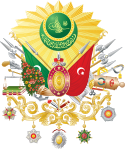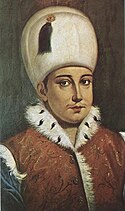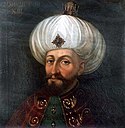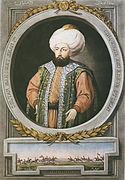Władcy Turcji
Imperium Osmańskie
Dynastia Osmanów
- Sulejman Szach (XIII w.)
- Ertogrul (druga połowa XIII w.)
| # | Sułtan | Portret | Od | Do | Tugra | Uwagi |
|---|---|---|---|---|---|---|
| 1 | Osman I (Bej) |  | c. 1299 | c. 1324 | – | |
| 2 | Orhan I (Bej) |  | c. 1324 | c. 1360 |  |
|
| 3 | Murad I Hüdavendigar (Sułtan od 1383) |  | c. 1360 | 1389 |  |
|
| 4 | Bajazyd I Błyskawica |  | 1389 | 1402 |
| |
| Interregnum (1402–1413) | ||||||
| 5 | Mehmed I |  | 1413 | 1421 |
| |
| 6 | Murad II |  | 1421 | 1444 |
| |
| 7 | Mehmed II Zdobywca |  | 1444 | 1446 | ||
| (6) | Murad II |  | 1446 | 3 lutego 1451 | ||
| (7) | Mehmed II Zdobywca |  | 3 lutego 1451 | 3 maja 1481 |
| |
| 8 | Bajazyd II |  | 19 maja 1481 | 25 kwietnia 1512 |
| |
| 9 | Selim I Groźny (Kalif od 1517) |  | 25 kwietnia 1512 | 21 września 1520 |
| |
| 10 | Sulejman I Wspaniały |  | 30 września 1520 | 6 lub 7 września 1566 |  |
|
| 11 | Selim II Pijak |  | 29 września 1566 | 21 grudnia 1574 | ||
| 12 | Murad III |  | 22 grudnia 1574 | 16 stycznia 1595 | ||
| 13 | Mehmed III |  | 27 stycznia 1595 | 20 lub 21 grudnia 1603 | ||
| 14 | Ahmed I |  | 21 grudnia 1603 | 22 listopada 1617 |
| |
| 15 | Mustafa I |  | 22 listopada 1617 | 26 lutego 1618 | ||
| 16 | Osman II |  | 26 lutego 1618 | 19 maja 1622 |
| |
| (15) | Mustafa I |  | 20 maja 1622 | 10 września 1623 |
| |
| 17 | Murad IV |  | 10 września 1623 | 8 lub 9 lutego 1640 |
| |
| 18 | Ibrahim I |  | 9 lutego 1640 | 8 sierpnia 1648 |
| |
| 19 | Mehmed IV |  | 8 sierpnia 1648 | 8 listopada 1687 |
| |
| 20 | Sulejman II |  | 8 listopada 1687 | 22 czerwca 1691 |
| |
| 21 | Ahmed II |  | 22 czerwca 1691 | 6 lutego 1695 |
| |
| 22 | Mustafa II |  | 6 lutego 1695 | 22 sierpnia 1703 |
| |
| 23 | Ahmed III |  | 22 sierpnia 1703 | 1 lub 2 października 1730 |
| |
| 24 | Mahmud I |  | 2 października 1730 | 13 grudnia 1754 |
| |
| 25 | Osman III |  | 13 grudnia 1754 | 29 lub 30 października 1757 |
| |
| 26 | Mustafa III |  | 30 października 1757 | 21 stycznia 1774 |
| |
| 27 | Abdülhamid I |  | 21 stycznia 1774 | 6 lub 7 kwietnia 1789 |
| |
| 28 | Selim III |  | 7 kwietnia 1789 | 29 maja 1807 |
| |
| 29 | Mustafa IV |  | 29 maja 1807 | 28 lipca 1808 |  |
|
| 30 | Mahmud II |  | 28 lipca 1808 | 1 lipca 1839 |
| |
| 31 | Abdülmecid I |  | 1 lipca 1839 | 25 czerwca 1861 |  |
|
| 32 | Abdülaziz |  | 25 czerwca 1861 | 30 maja 1876 |  |
|
| 33 | Murad V |  | 30 maja 1876 | 31 sierpnia 1876 |  |
|
| 34 | Abdülhamid II Wielki Chan |  | 31 sierpnia 1876 | 27 kwietnia 1909 |  |
|
| 35 | Mehmed V |  | 27 kwietnia 1909 | 3 lipca 1918 |  |
|
| 36 | Mehmed VI |  | 4 lipca 1918 | 1 listopada 1922 |  | |
| Rozwiązanie Imperium Osmańskiego (1922–1923) | ||||||
| – | Abdülmecid II (tylko kalif) |  | 18 listopada 1922 | 3 marca 1924 | – |
|
Uwagi
Tytuł sułtana używany był od panowania Orhana, Osman I posługiwał się tytułem beja. Daty panowania niektórych władców są dyskusyjne, np. według niektórych opracowań Murad II abdykował na korzyść Mehmeda II Zdobywcy już w latach 1444-1446, choć wiadomo skądinąd, iż faktyczną władzę Mehmed objął dopiero w 1451 r.
Przypisy
- ↑ Osman Gazi. Tureckie Ministerstwo Kultury i Turystyki. [dostęp 2011-03-04].
- ↑ Orchan Gazi. Tureckie Ministerstwo Kultury i Turystyki. [dostęp 2011-03-04].
- ↑ Sułtan Murad Hüdavendigar Han. Tureckie Ministerstwo Kultury i Turystyki. [dostęp 2011-03-04].
- ↑ Sultan Yıldırım Beyezid Han. Tureckie Ministerstwo Kultury i Turystyki. [dostęp 2011-03-04].
- ↑ Sultan Mehmed Çelebi Han. Tureckie Ministerstwo Kultury i Turystyki. [dostęp 2011-03-04].
- ↑ a b Sultan II. Murad Han. Tureckie Ministerstwo Kultury i Turystyki. [dostęp 2011-03-04].
- ↑ a b Chronology: Sultan II. Murad Han. Tureckie Ministerstwo Kultury i Turystyki. [dostęp 2011-03-04].
- ↑ Fatih Sultan Mehmed Han. Tureckie Ministerstwo Kultury i Turystyki. [dostęp 2011-03-04].
- ↑ Sultan II. Bayezid Han. Tureckie Ministerstwo Kultury i Turystyki. [dostęp 2011-03-04].
- ↑ Yavuz Sultan Selim Han. Tureckie Ministerstwo Kultury i Turystyki. [dostęp 2011-03-04].
- ↑ Kanuni Sultan Süleyman Han. Tureckie Ministerstwo Kultury i Turystyki. [dostęp 2011-03-04].
- ↑ Sultan II. Selim Han. Tureckie Ministerstwo Kultury i Turystyki. [dostęp 2011-03-04].
- ↑ Sultan III. Murad Han. Tureckie Ministerstwo Kultury i Turystyki. [dostęp 2011-03-04].
- ↑ Sultan III. Mehmed Han. Tureckie Ministerstwo Kultury i Turystyki. [dostęp 2011-03-04].
- ↑ Sultan I. Ahmed. Tureckie Ministerstwo Kultury i Turystyki. [dostęp 2011-03-04].
- ↑ a b Sultan I. Mustafa. Tureckie Ministerstwo Kultury i Turystyki. [dostęp 2011-03-04].
- ↑ Sultan II. Osman Han. Tureckie Ministerstwo Kultury i Turystyki. [dostęp 2011-03-04].
- ↑ Sultan IV. Murad Han. Tureckie Ministerstwo Kultury i Turystyki. [dostęp 2011-03-04].
- ↑ Sultan İbrahim Han. Tureckie Ministerstwo Kultury i Turystyki. [dostęp 2011-03-04].
- ↑ Sultan IV. Mehmed. Tureckie Ministerstwo Kultury i Turystyki. [dostęp 2011-03-04].
- ↑ Sultan II. Süleyman Han. Tureckie Ministerstwo Kultury i Turystyki. [dostęp 2011-03-04].
- ↑ Sultan II. Ahmed Han. Tureckie Ministerstwo Kultury i Turystyki. [dostęp 2011-03-04].
- ↑ Sultan II. Mustafa Han. Tureckie Ministerstwo Kultury i Turystyki. [dostęp 2011-03-04].
- ↑ Sultan III. Ahmed Han. Tureckie Ministerstwo Kultury i Turystyki. [dostęp 2011-03-04].
- ↑ Sultan I. Mahmud Han. Tureckie Ministerstwo Kultury i Turystyki. [dostęp 2011-03-04].
- ↑ Sultan III. Osman Han. Tureckie Ministerstwo Kultury i Turystyki. [dostęp 2011-03-04].
- ↑ Sultan III. Mustafa Han. Tureckie Ministerstwo Kultury i Turystyki. [dostęp 2011-03-04].
- ↑ Sultan I. Abdülhamit Han. Tureckie Ministerstwo Kultury i Turystyki. [dostęp 2011-03-04].
- ↑ Sultan III. Selim Han. Tureckie Ministerstwo Kultury i Turystyki. [dostęp 2011-03-04].
- ↑ Sultan IV. Mustafa Han. Tureckie Ministerstwo Kultury i Turystyki. [dostęp 2011-03-04].
- ↑ Sultan II. Mahmud Han. Tureckie Ministerstwo Kultury i Turystyki. [dostęp 2011-03-04].
- ↑ Sultan Abdülmecid Han. Tureckie Ministerstwo Kultury i Turystyki. [dostęp 2011-03-04].
- ↑ Sultan Abdülaziz Han. Tureckie Ministerstwo Kultury i Turystyki. [dostęp 2011-03-04].
- ↑ Sultan V. Murad Han. Tureckie Ministerstwo Kultury i Turystyki. [dostęp 2011-03-04].
- ↑ Sultan II. Abdülhamid Han. Tureckie Ministerstwo Kultury i Turystyki. [dostęp 2011-03-04].
- ↑ Sultan V. Mehmed Reşad Han. Tureckie Ministerstwo Kultury i Turystyki. [dostęp 2011-03-04].
- ↑ Sultan VI. Mehmed Vahdettin Han. Tureckie Ministerstwo Kultury i Turystyki. [dostęp 2011-03-04].
Media użyte na tej stronie
Tughra (i.e., seal or signature) of Osman III, Sultan of the Ottoman Empire (1754-1757). An explanation of the different elements composing the tughra can be found here.
Ahmet III
Ahmed II
Portret Abdul Hamid II, 34. sułtana i 113. Kalif Islamu İmperium Osmańskiego (1842 -1918).
Every sultan of the Ottoman Empire had his own monogram, called the tughra, which served as a royal symbol. A coat of arms in the European heraldic sense was created in the late 19th century. Hampton Court requested from the Ottoman Empire a coat of arms to be included in their collection. As the coat of arms had not been previously used in the Ottoman Empire, it was designed after this request, and the final design was adopted by Sultan Abdul Hamid II on 17 April 1882.
Yavuz Sultan Selim
Tughra (i.e., seal or signature) of Ahmed III, Sultan of the Ottoman Empire (1703-1730). An explanation of the different elements composing the tughra can be found here.
Tughra (i.e., seal or signature) of Ibrahim, Sultan of the Ottoman Empire (1640-1648). An explanation of the different elements composing the tughra can be found here.
Osman I
A life-size portrait of Sultan Murad III (1574-1595), attributed to a Spanish artist, 17th century
Tughra (i.e., seal or signature) of Mehmed IV, Sultan of the Ottoman Empire (1648-1687). An explanation of the different elements composing the tughra can be found here.
Tughra (i.e., seal or signature) of Murad V, Sultan of the Ottoman Empire for a few months in 1876. An explanation of the different elements composing the tughra can be found here.
Tughra (i.e., seal or signature) of Mahmud II, Sultan of the Ottoman Empire (1808-1839). An explanation of the different elements composing the tughra can be found here.
Seine Majestät Sultan Muhammed Chan V., Kaiser der Osmanen
Orhan
Tughra (i.e., seal or signature) of w:Orhan, Sultan of the Ottoman Empire (1326-1359). This is the first tughra ever used by an Ottoman sultan. An explanation of the different elements composing the tughra can be found here.
Tughra (i.e., seal or signature) of Mahmud I, Sultan of the Ottoman Empire (1730-1754). An explanation of the different elements composing the tughra can be found here.
Mustapha IV
Tughra (i.e., seal or signature) of Murad II, Sultan of the Ottoman Empire (1421-1451). An explanation of the different elements composing the tughra can be found here.
Murat I
Tughra (i.e., seal or signature) of Abdülhamid I, Sultan of the Ottoman Empire (1774-1789). An explanation of the different elements composing the tughra can be found here.
Delle tre versioni del ritratto di Solimano, ricordate dalle fonti come «di mano di Tiziano», ne sono giunte fino a noi solo due, iconograficamente diverse tra loro, ma entrambe riferibili alla bottega di Tiziano, piuttosto che alla sua mano. Ciò che per altro non vorrebbe dir nulla, perché molte opere di bottega venivano licenziate come autografe. Il primo ritratto di Solimano di stile tizianesco proviene dalla collezione dell’arciduca Ferdinando II d’Austria ed è registrato nell’inventario del castello di Ruhelust, nel 1596. Il quadro è stato esposto alla Mostra di Vienna nel 2007 come copia da Tiziano (Kunsthistorisches Museum, Gemäldegalerie, Inv.-Nr. 24291).
Tughra (i.e., seal or signature) of Selim I, Sultan of the Ottoman Empire (1512-1520). An explanation of the different elements composing the tughra can be found here.
Tughra (i.e., seal or signature) of Mehmed I, Sultan of the Ottoman Empire (1413-1421). An explanation of the different elements composing the tughra can be found here.
Osman II, 1604 - 1622, sultan of the Ottoman empire
Tughra (i.e., seal or signature) of Suleiman I (known as Suleiman the Magnificent or the Lawgiver), Sultan of the Ottoman Empire (1520-1566). An explanation of the different elements composing the tughra can be found here.
Tughra (i.e., seal or signature) of Mustafa II, Sultan of the Ottoman Empire (1695-1703). An explanation of the different elements composing the tughra can be found here.
Tughra (i.e., seal or signature) of Murad I, Sultan of the Ottoman Empire (1359-1389). An explanation of the different elements composing the tughra can be found here.
Tughra (i.e., seal or signature) of Mehmed III, Sultan of the Ottoman Empire (1595-1603). An explanation of the different elements composing the tughra can be found here.
Tughra (i.e., seal or signature) of Murad III, Sultan of the Ottoman Empire (1574-1595). An explanation of the different elements composing the tughra can be found here.
Tughra (i.e., seal or signature) of Selim III, Sultan of the Ottoman Empire (1789-1807). An explanation of the different elements composing the tughra can be found here.
Tughra (i.e., seal or signature) of Abdülaziz, Sultan of the Ottoman Empire (1861-1876). An explanation of the different elements composing the tughra can be found here.
27-cie Sułtan Imperium Osmańskiego i 106th Kalif İslamu; Abdulhamid I.(1725-1789)
Tughra (i.e., seal or signature) of Suleiman II, Sultan of the Ottoman Empire (1687-1691). An explanation of the different elements composing the tughra can be found here.
Tughra (i.e., seal or signature) of Ahmed II, Sultan of the Ottoman Empire (1691-1695). An explanation of the different elements composing the tughra can be found here.
Tughra (i.e., seal or signature) of Mehmed II, Sultan of the Ottoman Empire (1444-1446; 1451-1481). An explanation of the different elements composing the tughra can be found here.
Tughra (i.e., seal or signature) of Murad IV, Sultan of the Ottoman Empire (1623-1640). An explanation of the different elements composing the tughra can be found here.
Portret ostatniego kalifa Abdülmecida II z dynastii osmańskiej.
Mehmet I
Ahmet I
Tughra (i.e., seal or signature) of Mustafa I, Sultan of the Ottoman Empire (1617-1618; 1622-1623). An explanation of the different elements composing the tughra can be found here.
Tughra (i.e., seal or signature) of Selim II, Sultan of the Ottoman Empire (1566-1574). An explanation of the different elements composing the tughra can be found here.
Tughra (i.e., seal or signature) of Mehmed V, Sultan of the Ottoman Empire (1909-1918). An explanation of the different elements composing the tughra can be found here.
Tughra (i.e., seal or signature) of Mustafa III, Sultan of the Ottoman Empire (1757-1774). An explanation of the different elements composing the tughra can be found here.
Mustafa II, 1695-1703 the Ottoman Sultan
Tughra (i.e., seal or signature) of Abdülmecid I, Sultan of the Ottoman Empire (1839-1861). An explanation of the different elements composing the tughra can be found here.
33rd sułtan Imperium Osmańskiego i 112-ga kalif islamu; Murad V. (1840 -1904)
Osman III
Selim II
Tughra (i.e., seal or signature) of Ahmed I, Sultan of the Ottoman Empire (1603-1617). An explanation of the different elements composing the tughra can be found here.
Süleyman II
Sultan Abdulaziz of the Ottoman Empire
Tughra (i.e., seal or signature) of Abdülhamid II, Sultan of the Ottoman Empire (1876-1909). An explanation of the different elements composing the tughra can be found here.
:The portrait painted title appears to say "Baiazeth. P. IIII"
- Compare identification to https://collections.vam.ac.uk/item/O515417/turkish-sultans-sultanas-and-other-print-jungwierth/
Tughra (i.e., seal or signature) of Bayezid I, Sultan of the Ottoman Empire (1389-1402). An explanation of the different elements composing the tughra can be found here.
36. i ostatni Sułtan Imperium Osmańskiego również 115-ci Kalif İslamu; Mehmed VI.
Tughra (i.e., seal or signature) of Mehmed VI, last Sultan of the Ottoman Empire (1918-1922). An explanation of the different elements composing the tughra can be found here.
Portrait of sultan Mahmud II, given by Mustafa Reşid Pasha to king Louis-Philippe of France, now at the Musée de Versailles.
Autor: Buho07, Licencja: CC BY-SA 3.0
Ottoman Imperial Standard, Late 19th and early 20th Century. Each Sultan had his own Tughra.
Tughra (i.e., seal or signature) of Bayezid II, Sultan of the Ottoman Empire (1481-1512). An explanation of the different elements composing the tughra can be found here.
Tughra (i.e., seal or signature) of Osman II, Sultan of the Ottoman Empire (1618-1622). An explanation of the different elements composing the tughra can be found here.
8th Sultan of the Ottoman Empire, Bayezid II (1447 - 1512).
Tughra (i.e., seal or signature) of Mustafa IV, Sultan of the Ottoman Empire (1807-1808). An explanation of the different elements composing the tughra can be found here.









































































